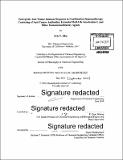Synergistic anti-tumor immune response to combination immunotherapy consisting of anti-tumor antibodies, extended half-life Interleukin-2, and other immunomodulatory agents
Author(s)
Zhu, Eric F. (Eric Franklin)
DownloadFull printable version (12.24Mb)
Alternative title
synergistic anti-tumor immune response to combination immunotherapy consisting of anti-tumor antibodies, serum-persistent Interleukin-2, and other immunomodulatory agents
Other Contributors
Massachusetts Institute of Technology. Department of Chemical Engineering.
Advisor
K. Dane Wittrup.
Terms of use
Metadata
Show full item recordAbstract
Cancer immunotherapies under development have generally focused on either stimulating T-cell immunity or driving antibody-directed effector functions of the innate immune system such as antibody-dependent cell-mediated cytotoxicity (ADCC). However, as our understanding of antitumor immune responses grows, it has become increasingly apparent that single agent therapies may be insufficient to effectively stimulate all aspects of a complex robust anti-tumor response in a large proportion of patients. Thus, rational combination of single agent immunotherapies has become an area of increasing interest. In this work, we find that a combination of an anti-tumor antigen antibody and an untargeted IL-2 fusion protein with delayed systemic clearance induces significant tumor control in aggressive isogenic tumor models via a concerted innate and adaptive response. We find that this therapy induces the infiltration of various immune effectors such as neutrophils, eosinophils NK cells, and CD8+ T-cells that appear to direct cytolytic activity against tumor cells. This combination therapy also induces an intratumoral "cytokine storm," potentially re-polarizing the tumor microenvironment into one that is immunologically anti-tumor. We also identify cross-talk between NK cells and macrophages to induce intratumoral recruitment of neutrophils but with the requisite presence of anti-tumor antibodies and IL-2 simultaneously. We further enhanced the efficacy of this two-component therapy with the addition of a potent amphiphile-based anti-tumor peptide vaccine in combination with checkpoint blockade of anti-PD-I and anti-CTLA-4. This multi-component therapy was tested in a setting of a low-mutational burden GEM lung cancer model with a single known and targetable antigen: human carcinoembryonic antigen (CEA). We find that in the subcutaneous setting and autochthonous setting, both components of checkpoint blockade are necessary for full efficacy. While a 5- component therapy is admittedly unwieldy for clinical translation, understanding the complementary yet non-overlapping contributions of each agent may inform improved development of additional immunotherapy agents and their combinations in the clinic.
Description
Thesis: Ph. D., Massachusetts Institute of Technology, Department of Chemical Engineering, 2016. Cataloged from PDF version of thesis. Includes bibliographical references (pages 109-123).
Date issued
2016Department
Massachusetts Institute of Technology. Department of Chemical EngineeringPublisher
Massachusetts Institute of Technology
Keywords
Chemical Engineering.